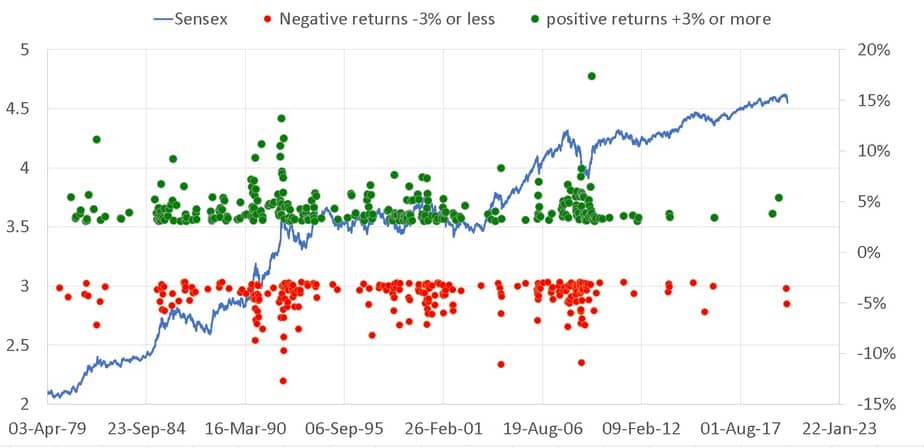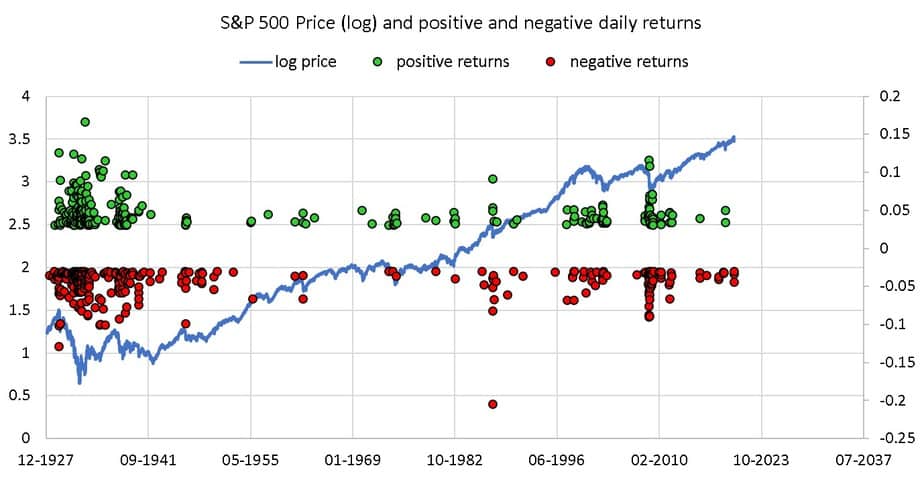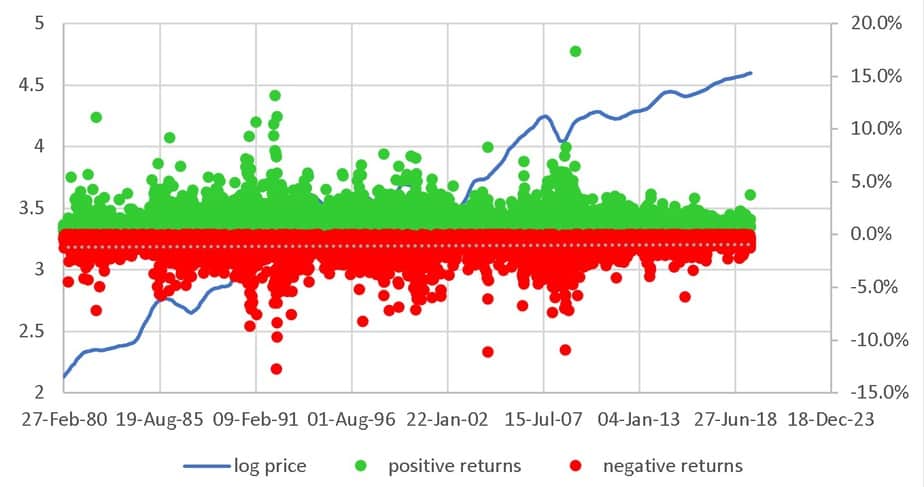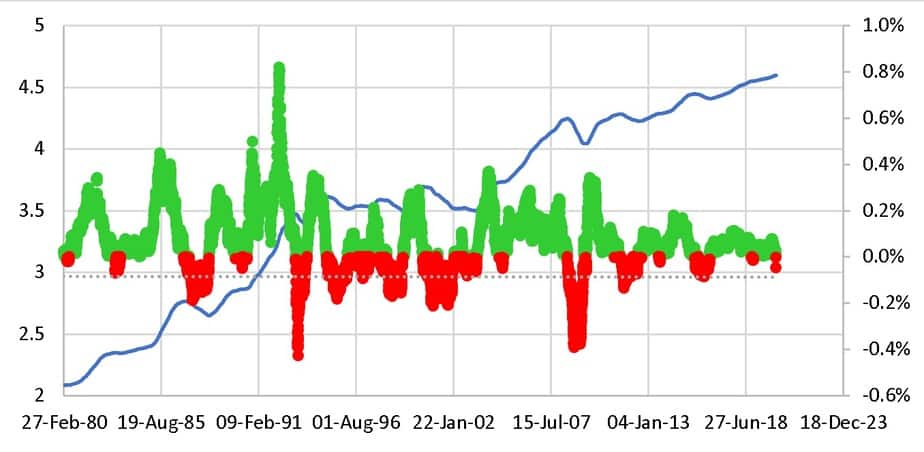Last Updated on December 29, 2021 at 5:25 pm
You might have heard the chant, “timing the market will not work, time in the market is what matters”. This is industry propaganda to ensure you do not exit your funds while the AMCs themselves have schemes with elaborate strategies to time the market. It is “ok” as long as they do it! In this report let us study daily returns of the Sensex and what we can learn about risk, reward and timing the market.
Timing the market is a method to reduce the impact of market fluctuation on a portfolio. It is a method to lower risk and the only guaranteed way to do that (as we shall see below) is to lower both up (positive) and down (negative) market movements. That is potential returns also gets lowered with potential risk.
Market timing is misunderstood as a way to get more returns. Worse, many people think merely invest on market dips without touching already invested money will work as they are scared of taxes. This has already been rebuffed here: Want to time the market? Then do it right! Buying on dips is not timing!
Join 32,000+ readers and get free money management solutions delivered to your inbox! Subscribe to get posts via email! (Link takes you to our email sign-up form)
🔥Want to create a complete financial plan? Learn goal-based investing? Exclusive access to our DIY tools? Increase your income with your skills? Use this link to enjoy massive discounts on our robo-advisory tool & courses! 🔥
There is only one way to time – change the total amount exposed to the full heat of the market from time to time regardless of taxes and exit loads. There are multiple methods to do this, each with its own success rates: using market PE, moving averages, double moving averages, Bollinger bands etc. The full archive of market timing backrests is available. A tool to determine market valuation in multiple ways is also available.
Timing the market refers to changing equity allocation in the portfolio as per market conditions. This is the same as tactical asset allocation.
These backtests already point out that market timing will work best if we try to reduce risk with it. Higher returns from these is pretty much a coin toss. If the sequence of returns are favourable then yes, if not no.
We shall try to understand the underlying reasons for this evidence in this article by looking at the daily returns of the Sensex and the S&P 500.
Let us first look at Sensex price movement (in log) and daily positive returns that are equal to or greater than 3% and daily negative returns that are equal to or less than -3%.

Notice how a big positive return is followed closely by a big negative return or vice-versa. A small positive return by a small negative return or vice-versa. I am much obliged to Siva from AIFW for urging me to plot both positive and negative returns together and for pointing out that this is volatility clustering. Or as pointed out first by Mandelbrot, “large changes tend to be followed by large changes, of either sign, and small changes tend to be followed by small changes.”
This can be viewed as an example of self-similarity or repetition of fluctuation observed over days to those over weeks or months. Regular readers may recall earlier articles on this matter: (1) The 80/20 rule: Making sense of the richest 1% Indians owning 58% wealth! (2) Five Books That Will Redefine Your Understanding of Stock Markets (3) Fractals: The True Nature of Stock Market Returns.
It has been shown that volatility clustering implies that stock returns overtime are correlated. Meaning that the market returns do not exhibit a random walk. This could also be the reason why the sequence of returns risk plays an important role in portfolio management why we need to reduce its impact
This is volatility clustering in the S&P 500 since 1927.

Now, the key point here is, just like in life, the good is always mixed with the bad. We cannot pick and choose the green dots (positive returns) and or pick and reject the red dots (negative returns).
If we try to reduce the impact of the red dots, we will end up reducing the impact of the green dots as well. If we try to enhance the impact of the green dots then we make the red dots more pronounced.
However, market returns are not symmetric. As shown before, we can visualise the growth of an equity portfolio as a tilted pendulum. That is, it swings on both sides but is a bit tilted to the positive side. This can be exploited but not to beat the market in terms of higher return but in terms of lower risk.
First, let us look at Sensex positive and negative daily returns without the 3% threshold.

There are a total of 9431 data points. Out of these 4963 are green and 4468 red. So pretty much an even split! Suppose we take the average of the last 200 days closing price, also known as daily moving average and 200 DMA. Then find how much this changes each day we get this.

Now there are 9232 data points out of which 6685 are positive. Taking the moving average reduced noise and to some extent reduces the volatility clustering. However, the problem is the extent of the green dots (and red dots) is also significantly lower. That is the price of the smoothening.
Now if we devise a strategy to be invested in equity only if price > 200 DMA and pull out if price falls below 200 DMA (yes, this seems counterintuitive but the idea is to not hold equity when the market has moved up “too much”) then the returns would approximately depend on the daily swings of the 200 DMA shown above. This is a backtest: Market Timing With Ten-Month Moving Average: Tactical Asset Allocation Backtest (200 DMA is approximately the same as a ten-month moving average).
It is naive to assume that we can beat the market because the smoothening has resulted in more positive movements. The problem is, we can only drown out both the positive and negative data points. Also, we have no clue when the red dots would occur in future.
While studying past return sequences, our portfolio might beat the market (= higher return) if we very few red dots or red dots early in the investment window. If the market falls big then we may not be getting more returns than the market.
However, since volatility has been uniformed reduced, a tactical asset allocated portfolio will not swing as much as the market does. It is in this sense and only in this sense we can time the market. Lower volatility, typically more frequent lower drawdown is the consistent benefits of market timing.
Getting more absolute returns is a matter of timing luck. That is it depends on the sequence of returns we would encounter in future. There is little benefit in counting on it “because it feels like commonsense”.

Use our Robo-advisory Tool to create a complete financial plan! ⇐More than 3,000 investors and advisors use this! Use the discount code: robo25 for a 20% discount. Plan your retirement (early, normal, before, and after), as well as non-recurring financial goals (such as child education) and recurring financial goals (like holidays and appliance purchases). The tool would help anyone aged 18 to 80 plan for their retirement, as well as six other non-recurring financial goals and four recurring financial goals, with a detailed cash flow summary.
🔥You can also avail massive discounts on our courses and the freefincal investor circle! 🔥& join our community of 8000+ users!
Track your mutual funds and stock investments with this Google Sheet!
We also publish monthly equity mutual funds, debt and hybrid mutual funds, index funds, and ETF screeners, as well as momentum and low-volatility stock screeners.
You can follow our articles on Google News

We have over 1,000 videos on YouTube!

Join our WhatsApp Channel



- Do you have a comment about the above article? Reach out to us on Twitter: @freefincal or @pattufreefincal
- Have a question? Subscribe to our newsletter using the form below.
- Hit 'reply' to any email from us! We do not offer personalised investment advice. We can write a detailed article without mentioning your name if you have a generic question.
Join 32,000+ readers and get free money management solutions delivered to your inbox! Subscribe to get posts via email! (Link takes you to our email sign-up form)
About The Author
 Dr M. Pattabiraman (PhD) is the founder, managing editor and primary author of freefincal. He is an associate professor at the Indian Institute of Technology, Madras. He has over 13 years of experience publishing news analysis, research and financial product development. Connect with him via Twitter(X), LinkedIn, or YouTube. Pattabiraman has co-authored three print books: (1) You can be rich too with goal-based investing (CNBC TV18) for DIY investors. (2) Gamechanger for young earners. (3) Chinchu Gets a Superpower! for kids. He has also written seven other free e-books on various money management topics. He is a patron and co-founder of “Fee-only India,” an organisation promoting unbiased, commission-free, AUM-independent investment advice.
Dr M. Pattabiraman (PhD) is the founder, managing editor and primary author of freefincal. He is an associate professor at the Indian Institute of Technology, Madras. He has over 13 years of experience publishing news analysis, research and financial product development. Connect with him via Twitter(X), LinkedIn, or YouTube. Pattabiraman has co-authored three print books: (1) You can be rich too with goal-based investing (CNBC TV18) for DIY investors. (2) Gamechanger for young earners. (3) Chinchu Gets a Superpower! for kids. He has also written seven other free e-books on various money management topics. He is a patron and co-founder of “Fee-only India,” an organisation promoting unbiased, commission-free, AUM-independent investment advice.Our flagship course! Learn to manage your portfolio like a pro to achieve your goals regardless of market conditions! ⇐ More than 3,500 investors and advisors are part of our exclusive community! Get clarity on how to plan for your goals and achieve the necessary corpus no matter the market condition!! Watch the first lecture for free! One-time payment! No recurring fees! Life-long access to videos! Reduce fear, uncertainty and doubt while investing! Learn how to plan for your goals before and after retirement with confidence.
Increase your income by getting people to pay for your skills! ⇐ More than 800 salaried employees, entrepreneurs and financial advisors are part of our exclusive community! Learn how to get people to pay for your skills! Whether you are a professional or small business owner seeking more clients through online visibility, or a salaried individual looking for a side income or passive income, we will show you how to achieve this by showcasing your skills and building a community that trusts and pays you. (watch 1st lecture for free). One-time payment! No recurring fees! Life-long access to videos!
Our book for kids: “Chinchu Gets a Superpower!” is now available!


Must-read book even for adults! This is something that every parent should teach their kids right from their young age. The importance of money management and decision making based on their wants and needs. Very nicely written in simple terms. - Arun.Buy the book: Chinchu gets a superpower for your child!
How to profit from content writing: Our new ebook is for those interested in getting a side income via content writing. It is available at a 50% discount for Rs. 500 only!
Do you want to check if the market is overvalued or undervalued? Use our market valuation tool (it will work with any index!), or get the Tactical Buy/Sell timing tool!
We publish monthly mutual fund screeners and momentum, low-volatility stock screeners.
About freefincal & its content policy. Freefincal is a News Media organisation dedicated to providing original analysis, reports, reviews and insights on mutual funds, stocks, investing, retirement and personal finance developments. We do so without conflict of interest and bias. Follow us on Google News. Freefincal serves more than three million readers a year (5 million page views) with articles based only on factual information and detailed analysis by its authors. All statements made will be verified with credible and knowledgeable sources before publication. Freefincal does not publish paid articles, promotions, PR, satire or opinions without data. All opinions will be inferences backed by verifiable, reproducible evidence/data. Contact Information: To get in touch, please use our contact form. (Sponsored posts or paid collaborations will not be entertained.)
Connect with us on social media
- Twitter @freefincal
- Subscribe to our YouTube Videos
- Posts feed via Feedburner.
Our publications
You Can Be Rich Too with Goal-Based Investing
 Published by CNBC TV18, this book is designed to help you ask the right questions and find the correct answers. Additionally, it comes with nine online calculators, allowing you to create custom solutions tailored to your lifestyle. Get it now.
Published by CNBC TV18, this book is designed to help you ask the right questions and find the correct answers. Additionally, it comes with nine online calculators, allowing you to create custom solutions tailored to your lifestyle. Get it now.Gamechanger: Forget Startups, Join Corporate & Still Live the Rich Life You Want
 This book is designed for young earners to get their basics right from the start! It will also help you travel to exotic places at a low cost! Get it or gift it to a young earner.
This book is designed for young earners to get their basics right from the start! It will also help you travel to exotic places at a low cost! Get it or gift it to a young earner.Your Ultimate Guide to Travel
 This is an in-depth exploration of vacation planning, including finding affordable flights, budget accommodations, and practical travel tips. It also examines the benefits of travelling slowly, both financially and psychologically, with links to relevant web pages and guidance at every step. Get the PDF for Rs 300 (instant download)
This is an in-depth exploration of vacation planning, including finding affordable flights, budget accommodations, and practical travel tips. It also examines the benefits of travelling slowly, both financially and psychologically, with links to relevant web pages and guidance at every step. Get the PDF for Rs 300 (instant download)